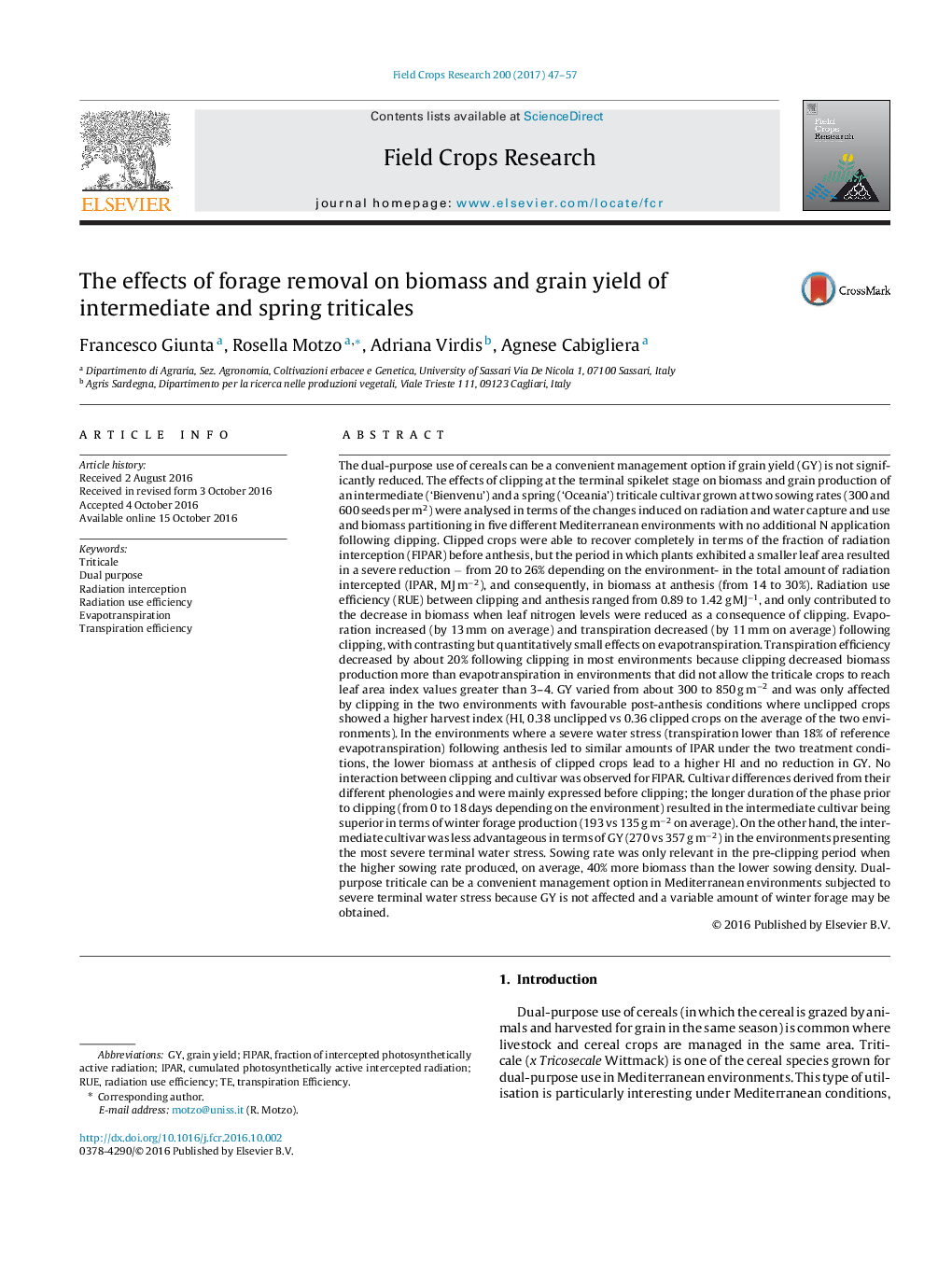| کد مقاله | کد نشریه | سال انتشار | مقاله انگلیسی | نسخه تمام متن |
|---|---|---|---|---|
| 4509805 | 1624663 | 2017 | 11 صفحه PDF | دانلود رایگان |
• Biomass at anthesis was reduced by clipping due to reduced radiation interception.
• When terminal drought removed LAI differences due to clipping, grain yield was not reduced.
• Biomass production was more affected by clipping than evapotranspiration when LAI was below 4.
• Phenology was the main cause of cultivar differences in dual-purpose suitability.
The dual-purpose use of cereals can be a convenient management option if grain yield (GY) is not significantly reduced. The effects of clipping at the terminal spikelet stage on biomass and grain production of an intermediate (‘Bienvenu’) and a spring (‘Oceania’) triticale cultivar grown at two sowing rates (300 and 600 seeds per m2) were analysed in terms of the changes induced on radiation and water capture and use and biomass partitioning in five different Mediterranean environments with no additional N application following clipping. Clipped crops were able to recover completely in terms of the fraction of radiation interception (FIPAR) before anthesis, but the period in which plants exhibited a smaller leaf area resulted in a severe reduction − from 20 to 26% depending on the environment- in the total amount of radiation intercepted (IPAR, MJ m−2), and consequently, in biomass at anthesis (from 14 to 30%). Radiation use efficiency (RUE) between clipping and anthesis ranged from 0.89 to 1.42 g MJ−1, and only contributed to the decrease in biomass when leaf nitrogen levels were reduced as a consequence of clipping. Evaporation increased (by 13 mm on average) and transpiration decreased (by 11 mm on average) following clipping, with contrasting but quantitatively small effects on evapotranspiration. Transpiration efficiency decreased by about 20% following clipping in most environments because clipping decreased biomass production more than evapotranspiration in environments that did not allow the triticale crops to reach leaf area index values greater than 3–4. GY varied from about 300 to 850 g m−2 and was only affected by clipping in the two environments with favourable post-anthesis conditions where unclipped crops showed a higher harvest index (HI, 0.38 unclipped vs 0.36 clipped crops on the average of the two environments). In the environments where a severe water stress (transpiration lower than 18% of reference evapotranspiration) following anthesis led to similar amounts of IPAR under the two treatment conditions, the lower biomass at anthesis of clipped crops lead to a higher HI and no reduction in GY. No interaction between clipping and cultivar was observed for FIPAR. Cultivar differences derived from their different phenologies and were mainly expressed before clipping; the longer duration of the phase prior to clipping (from 0 to 18 days depending on the environment) resulted in the intermediate cultivar being superior in terms of winter forage production (193 vs 135 g m−2 on average). On the other hand, the intermediate cultivar was less advantageous in terms of GY (270 vs 357 g m−2) in the environments presenting the most severe terminal water stress. Sowing rate was only relevant in the pre-clipping period when the higher sowing rate produced, on average, 40% more biomass than the lower sowing density. Dual-purpose triticale can be a convenient management option in Mediterranean environments subjected to severe terminal water stress because GY is not affected and a variable amount of winter forage may be obtained.
Journal: Field Crops Research - Volume 200, January 2017, Pages 47–57
